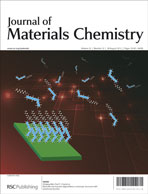A series of highly polarizable chromophores 1–3 has been synthesized based on three different types of electron donors, including diethylaminophenyl, tetrahydroquinolinyl and julolidinyl groups respectively, with the same isophorone-derived tetraene bridges and strong CF3–TCF acceptors. The progressively increased electron-donating strength for these chromophores allows for the fine-tuning of their molecular ground-state polarization, being very close to optimal for very large hyperpolarizability (β), as a function of the local dielectric environment and poling-induced acentric ordering. The solvatochromic study and DFT calculations suggested that more dipolar chromophores 2 and 3 with stronger donating groups can be polarized quite close to the cyanine limit, or even beyond that into the zwitterionic regime in the most polar solvents to give the inverted solvatochromism and diminished β values. This is in stark contrast to the polyene-like characteristic of 1 with the diethylaminophenyl donor in all the tested solvents. Most intriguingly, the electric field poling has induced significant changes in the position, intensity and shape of the chromophoric charge-transfer absorption band in their poled thin films. It is thus indicated that the nontrivial intermolecular interaction in solid state can vary the reaction field that acts on the chromophores in poled and depoled films, and significantly affect their achievable electro-optic (EO) activities. As a result, the guest–host polymers containing 10 wt% of chromophores in PMMA showed EO coefficients of ∼80 pm V−1 for 1/PMMA and 2/PMMA, while dramatically dropping to 20 pm V−1 for 3/PMMA. These systematic analyses led to the rational design of a new guest–host EO polymer incorporating 35 wt% of a spatially modified chromophore AJLZ55, which gave ultrahigh EO coefficients of 218 pm V−1 at 1.31 μm.

You have access to this article
 Please wait while we load your content...
Something went wrong. Try again?
Please wait while we load your content...
Something went wrong. Try again?


 Please wait while we load your content...
Please wait while we load your content...